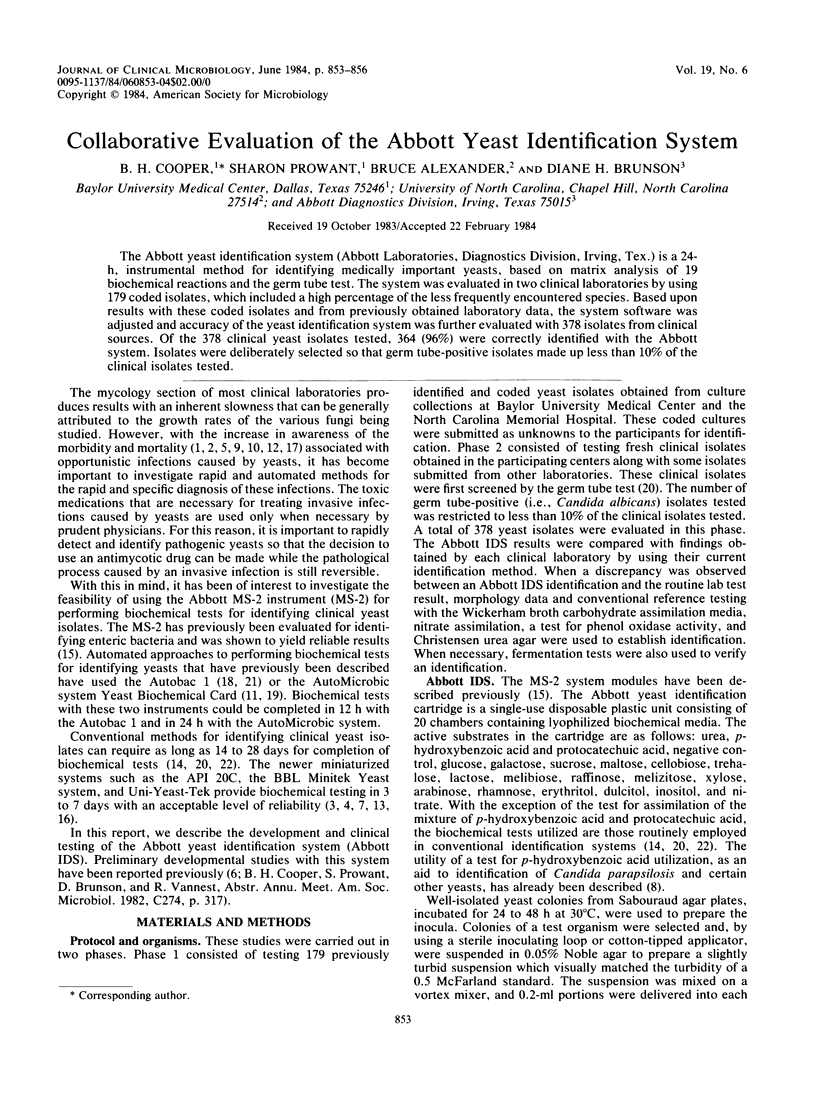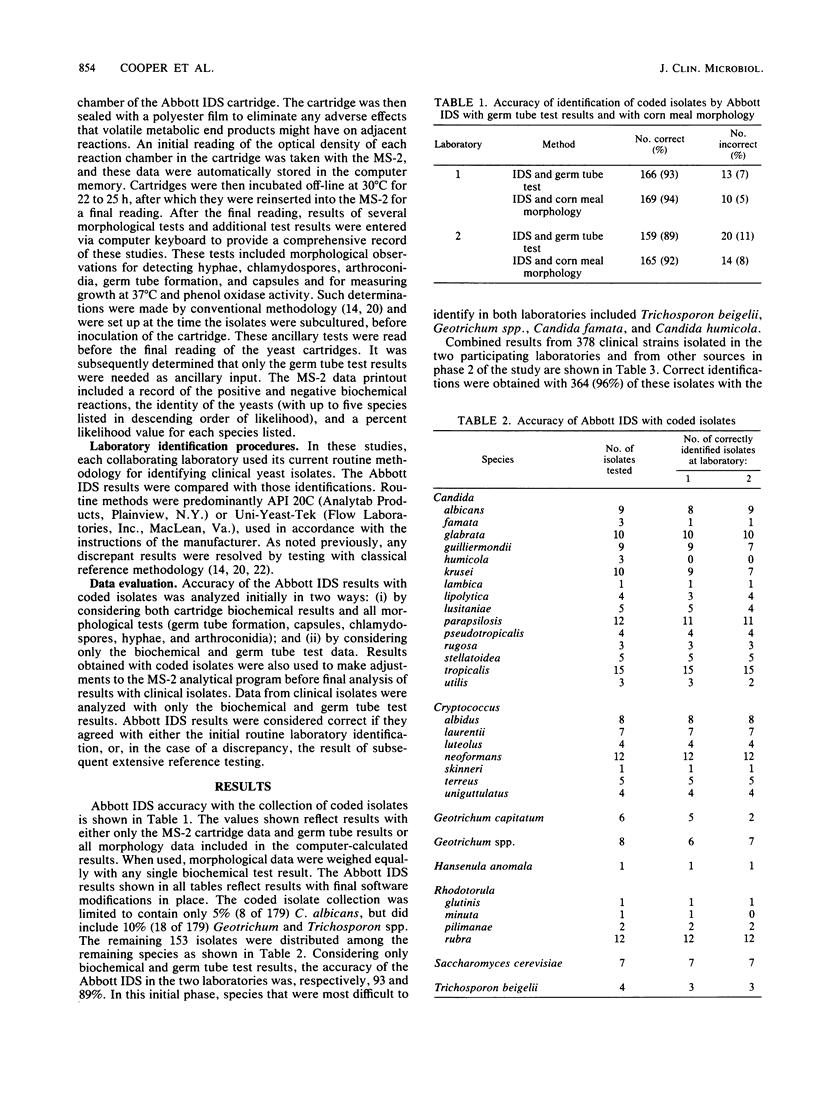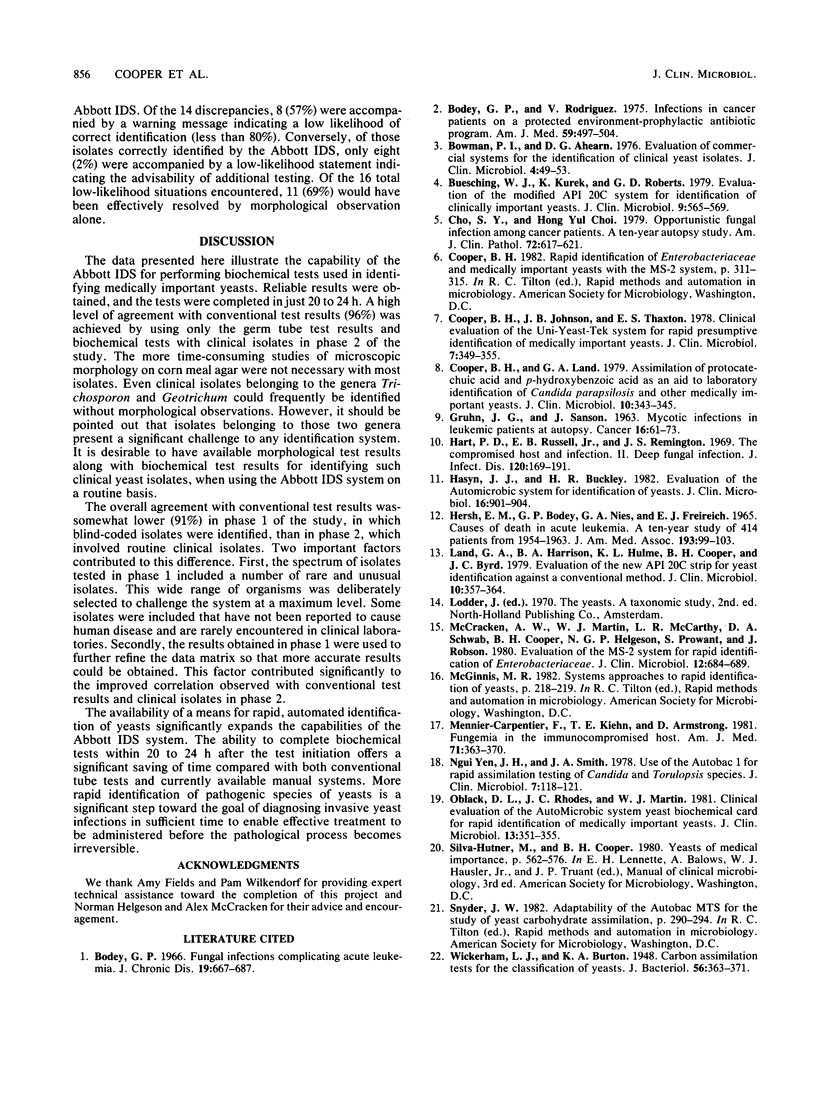Abstract
The Abbott yeast identification system (Abbott Laboratories, Diagnostics Division, Irving, Tex.) is a 24-h, instrumental method for identifying medically important yeasts, based on matrix analysis of 19 biochemical reactions and the germ tube test. The system was evaluated in two clinical laboratories by using 179 coded isolates, which included a high percentage of the less frequently encountered species. Based upon results with these coded isolates and from previously obtained laboratory data, the system software was adjusted and accuracy of the yeast identification system was further evaluated with 378 isolates from clinical sources. Of the 378 clinical yeast isolates tested, 364 (96%) were correctly identified with the Abbott system. Isolates were deliberately selected so that germ tube-positive isolates made up less than 10% of the clinical isolates tested.
Full text
PDF



Selected References
These references are in PubMed. This may not be the complete list of references from this article.
- Bodey G. P. Fungal infections complicating acute leukemia. J Chronic Dis. 1966 Jun;19(6):667–687. doi: 10.1016/0021-9681(66)90066-x. [DOI] [PubMed] [Google Scholar]
- Bodey G. P., Rodriguez V. Infections in cancer patients on a protected environment-prophylactic antibiotic program. Am J Med. 1975 Oct;59(4):497–504. doi: 10.1016/0002-9343(75)90257-0. [DOI] [PubMed] [Google Scholar]
- Bowman P. I., Ahearn D. G. Evaluation of commercial systems for the identification of clinical yeast isolates. J Clin Microbiol. 1976 Jul;4(1):49–53. doi: 10.1128/jcm.4.1.49-53.1976. [DOI] [PMC free article] [PubMed] [Google Scholar]
- Buesching W. J., Kurek K., Roberts G. D. Evaluation of the modified API 20C system for identification of clinically important yeasts. J Clin Microbiol. 1979 May;9(5):565–569. doi: 10.1128/jcm.9.5.565-569.1979. [DOI] [PMC free article] [PubMed] [Google Scholar]
- Cho S. Y., Choi H. Y. Opportunistic fungal infection among cancer patients. A ten-year autopsy study. Am J Clin Pathol. 1979 Oct;72(4):617–621. doi: 10.1093/ajcp/72.4.617. [DOI] [PubMed] [Google Scholar]
- Cooper B. H., Johnson J. B., Thaxton E. S. Clinical evaluation of the Uni-Yeast-Tek system for rapid presumptive identification of medically important yeasts. J Clin Microbiol. 1978 Apr;7(4):349–355. doi: 10.1128/jcm.7.4.349-355.1978. [DOI] [PMC free article] [PubMed] [Google Scholar]
- Cooper B. H., Land G. A. Assimilation of protocatechuic acid and p-hydroxybenzoic acid as an aid to laboratory identification of Candida parapsilosis and other medically important yeasts. J Clin Microbiol. 1979 Sep;10(3):343–345. doi: 10.1128/jcm.10.3.343-345.1979. [DOI] [PMC free article] [PubMed] [Google Scholar]
- GRUHN J. G., SANSON J. Mycotic infections in leukemic patients at autopsy. Cancer. 1963 Jan;16:61–73. doi: 10.1002/1097-0142(196301)16:1<61::aid-cncr2820160109>3.0.co;2-z. [DOI] [PubMed] [Google Scholar]
- Hart P. D., Russell E., Jr, Remington J. S. The compromised host and infection. II. Deep fungal infection. J Infect Dis. 1969 Aug;120(2):169–191. doi: 10.1093/infdis/120.2.169. [DOI] [PubMed] [Google Scholar]
- Hasyn J. J., Buckley H. R. Evaluation of the AutoMicrobic system for identification of yeasts. J Clin Microbiol. 1982 Nov;16(5):901–904. doi: 10.1128/jcm.16.5.901-904.1982. [DOI] [PMC free article] [PubMed] [Google Scholar]
- LEONARDS J. R., LEVY G. ABSORPTION AND METABOLISM OF ASPIRIN ADMINISTERED IN ENTERIC-COATED TABLETS. JAMA. 1965 Jul 12;193:99–104. doi: 10.1001/jama.1965.03090020013004. [DOI] [PubMed] [Google Scholar]
- Land G. A., Harrison B. A., Hulme K. L., Cooper B. H., Byrd J. C. Evaluation of the new API 20C strip for yeast identification against a conventional method. J Clin Microbiol. 1979 Sep;10(3):357–364. doi: 10.1128/jcm.10.3.357-364.1979. [DOI] [PMC free article] [PubMed] [Google Scholar]
- McCracken A. W., Martin W. J., McCarthy L. R., Schwab D. A., Cooper B. H., Helgeson N. G., Prowant S., Robson J. Evaluation of the MS-2 system for rapid identification of Enterobacteriaceae. J Clin Microbiol. 1980 Nov;12(5):684–689. doi: 10.1128/jcm.12.5.684-689.1980. [DOI] [PMC free article] [PubMed] [Google Scholar]
- Meunier-Carpentier F., Kiehn T. E., Armstrong D. Fungemia in the immunocompromised host. Changing patterns, antigenemia, high mortality. Am J Med. 1981 Sep;71(3):363–370. doi: 10.1016/0002-9343(81)90162-5. [DOI] [PubMed] [Google Scholar]
- Ngui Yen J. H., Smith J. A. Use of Autobac 1 for rapid assimilation testing of Candida and Torulopsis species. J Clin Microbiol. 1978 Feb;7(2):118–121. doi: 10.1128/jcm.7.2.118-121.1978. [DOI] [PMC free article] [PubMed] [Google Scholar]
- Oblack D. L., Rhodes J. C., Martin W. J. Clinical evaluation of the AutoMicrobic system Yeast Biochemical Card for rapid identification of medically important yeasts. J Clin Microbiol. 1981 Feb;13(2):351–355. doi: 10.1128/jcm.13.2.351-355.1981. [DOI] [PMC free article] [PubMed] [Google Scholar]
- Wickerham L. J., Burton K. A. Carbon Assimilation Tests for the Classification of Yeasts. J Bacteriol. 1948 Sep;56(3):363–371. doi: 10.1128/jb.56.3.363-371.1948. [DOI] [PMC free article] [PubMed] [Google Scholar]


